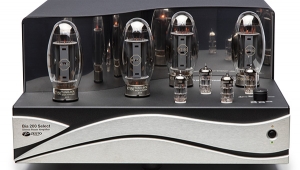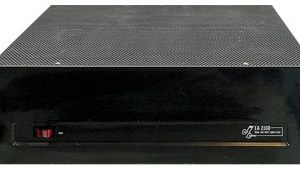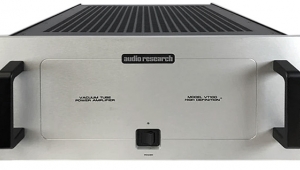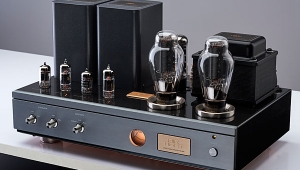| Columns Retired Columns & Blogs |
VTL MB300 & MB450 Signature monoblock amplifiers
Not only does the venerable vacuum tube refuse to lie down and die, as everyone predicted when audio went solid-state; it continues to deliver better performance than anyone had imagined it could. Only a few years ago, we could characterize "the tube sound" as being sweet but soft at the high end, rich but loose in the midbass, deficient in deep bass, and bright and forward, usually with excellent reproduction of depth. Since then, we've seen the introduction of what might almost be called a new generation of tube amplifiers, which rival solid-state units in those areas where tubes used to have weaknesses, but have given up little of the tube's sonic strengths.
Although a number of firms are making tube products, the name most of us think of in that connection is Audio Research, whose huge M-300 power amplifier has earned a reputation as the pinnacle of tube power-amplifier design. The M-300 may now have to share that honor with a product from an upstart company that few audiophiles have even heard of.
VTL's design approach is diametrically opposed to Audio Research's. ARC's electronics tend to be very complex, with many cascaded active stages and lots of "support" circuits to maintain stability, regulate operating parameters, and cancel distortion products. VTL designs are more like David Hafler's, in that they reflect a conviction (shared by many audiophiles) that the fewer active circuits in the signal path, the better the sound. Much of VTL's circuitry is right out of the classic design textbooks of the 1950s (like the Radiotron Designer's Handbook). The differences, mainly, are in the application of much more rigorous standards of performance and component accuracy than were ever considered necessary in those days, plus the use of the highest quality passive devices (capacitors, transformers, wires) that modern technology has to offer.
The tube lineup in each Monoblock 300 consists of a 12AT7 dual triode, a 12BH7 dual triode, and two groups of four 6550 power output tubes. Both sections of the first tube are connected in parallel, which doubles their transconductance (gain), lowers noise and output impedance, and doubles the amount of headroom. The two halves of the second tube comprise a long-tailed-pair phase inverter/splitter that delivers enough signal to drive the 6550s to full output without the need for dedicated driver stages. Each group of four output tubes is paralleled as half of a push-pull circuit, and the tubes are fixed-biased at class-A1.
In fixed-biasing, an external negative supply holds the grids at a predetermined operating point regardless of the tube's instantaneous plate current. In cathode biasing, the bias voltage is produced as the result of the tube's plate current passing through a cathode resistor. Because the bias affects both gain and distortion, and varies with the plate current, cathode biasing requires that the no-signal plate current be set fairly high, to prevent negative-voltage swings from biasing the tube to cutoff. Fixed bias, which is unaffected by the signal, needs no such safety margin, so it can be set for a much lower quiescent plate current, while still retaining the low distortion characteristics of class-A operation. The 300's 6550s each draw around 35 milliamps of current under no-signal conditions, as opposed to around 60mA in most other 6550 designs. This is one reason why VTL amps achieve such long tube life that the firm can offer a 6-month warranty on tubes. (According to VTL, fixed biasing also delivers up to 70% more output power at lower distortion than does cathode biasing.)
It should be remembered that the terms "biasing up" and "biasing down" refer to the effect of the bias on a tube's plate current, not on the direction of change of the bias voltage itself. A negative-polarity DC voltage on the control grid, with respect to the cathode, acts to reduce current flow through the tube, and it is necessary that that current be limited in order to minimize distortion and prevent the tube from incinerating itself. Making the grid less negative, or making the cathode more positive, will increase the current flow through the tube.
Another, not-insignificant advantage of the 300's low-current biasing is that it needs no cooling fan. While many fans are very quiet, none that I have encountered have been silent enough that you couldn't hear them during quiet passages when playing a CD, or when not playing anything at all. The 300 is dead-quiet.
Both of the hefty transformers on this amplifier are designed and built by VTL. The power transformer, which has six windings (including two in parallel for the primary), feeds a full-wave solid-state rectifier bridge (over-)rated at 1500 PIV breakdown and 2.5 amps current. There is no resistive or inductive smoothing filter in series with the B+ supply to isolate it from the AC line, so B+ source impedance is about as low as one can get. This ensures a very high degree of supply regulation without the problems of response time inherent in regulator circuits. The power supply is at 550V with 1650µF of storage capacitance, giving 250 joules of reserve energy storage. (The Audio Research M-300 stores 350 joules; most high-end solid-state amps store 35.) Additionally, the dual-triode voltage amplifier and phase-inverter tubes are separately powered from their own transformer winding.
- Log in or register to post comments



































